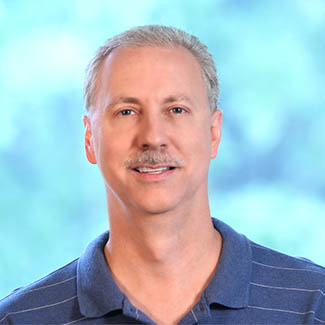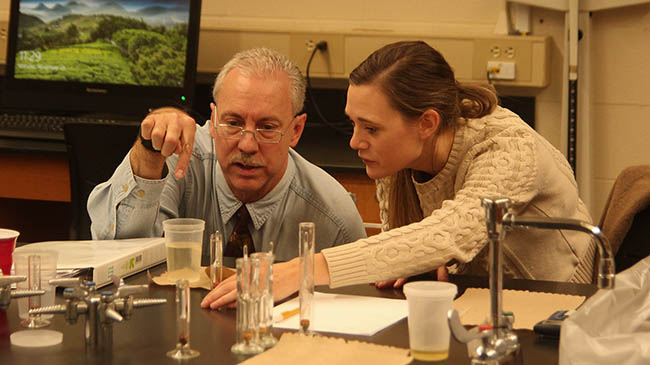
By Steven Krolak
(NEW ALBANY, Ind.)—It’s urinalysis day in the Physiology 215 Lab, taught by Professor of Biology Dr. Kent Edmonds.
Over the course of the two-hour lab, students consume specified amounts of water, saline and bicarbonate solutions, and then, every half hour, collect their own personal urine specimen in the nearby restroom.
They subject their specimens to tests designed to demonstrate alterations in volume, solute concentration, and pH of urine produced by the kidney.
Volume is determined by reading the side of calibrated urine collection cubs, pH is identified by using a pH meter, specific gravity is determined with the aid of a float calibration scale, and chloride concentration is found by mixing the urine with a solution of potassium chromate and silver nitrate, and then observing the resulting color changes. A urinometer helps determine the concentration of particulate matter in the sample.
There is a good-humored but focused choreography to the movements of the 22 students in the class. They are working against the clock, and at this point in the semester, their actions appear routine. Edmonds circulates, assists individuals, responds to questions, addresses the class to encourage and to remind, providing a sense of tempo to the proceedings.
This is foundational lab work.
As far as can be observed, there is not a single innovation in sight.
But what if innovation isn’t what we commonly think?
What if it isn’t a radical departure from the norm?
What if it is something more subtle, a way of synthesizing novel impulses with continuity and tradition?
What if it is not obvious, but an inner process of evolution and self-improvement?
What if it is something that manifests itself not in a new arrangement of desks or a novel take on group projects, but in a more intangible essence, such as an attitude, a mentality, a vision?
Is it not still innovation?
The pyramid of success
Edmonds grew up in Torrance, California, a suburb of Los Angeles. In a region known for reckless aspirations—actors, rock stars, surfers–Edmonds was committed to different, and more serious, bearings.
From the age of eight, he wanted to be a doctor.
He recalls being always self-directed, influenced by his parents and then by a towering figure from the world of athletics.
In the 1960s and 1970s, Los Angeles was the city of UCLA basketball and its trailblazing coach/guru, John Wooden, who led the Bruins to 10 national championships. Wooden was a slender, soft-spoken figure behind scholarly wire-rimmed spectacles that betrayed a relentless analytical acumen and an inner drive to succeed. In an age of hair-pullers and chair-throwers, he was a nuclear physicist and chess champion and monk, all wrapped into one.
Wooden became known for his “pyramid of success,” an interlocking scaffold of qualities, attributes and motivations that guided him and his team across the decades: industriousness, enthusiasm, intentness, friendship, adaptability, reliability, confidence, poise and more.
In his books, Wooden expressed his thinking with characteristic directness: “Success is peace of mind that is the direct result of self-satisfaction in knowing you did your best to become the best that you are capable of becoming.”
Edmonds has Wooden’s pyramid poster on the wall of his office. He has read Wooden’s books. And he has internalized his philosophy into a code of personal and professional conduct that is equally at home in the classroom or lab as it is on the basketball court.
It’s about making the right decisions at the right time, something Edmonds has taken to heart.
When Edmonds analyzed the cost of med school and the life-style trade-offs involved, he calmly diverted his path to research. Inspired by an undergraduate mentor in endocrinology, he found his passion, and set about systematically searching for the best place to pursue it, landing ultimately at the University of Delaware.
Here he became acquainted with the species that became the focus of his life’s work: the marsh rice rat, Oryzomys palustris.
For about 28 of the past 32 years, Edmonds has been studying this particular rodent with a singular dedication. And over time, that dedication has yielded insights into the workings of this particular rodent, and by extension into the physiological processes it shares with humans.
He has researched, presented and/or published on this animal’s social cues, pituitary and gonadal hormones, pharmacological regulation and aging related to melatonin production, the effects of melatonin and auxin on its growth and reproductive development, the effects of photoperiod, ethanol, melatonin, food availability, adrenal and gonadal steroids, castration, ovariectomy, constant light, and hypothyroidism on the growth of its gastrointestinal system, the effects of environmental enrichment on its reproduction, and much more.
Research like this, in depth and over time, is not about being a one-hit wonder. Nobel Prizes are given out for achievements logged so long ago that most recipients are surprised when they get the phone call from Stockholm. No, this is about a scholarly life built on the foundation of the Wooden virtues of being detail-oriented and enjoying the challenge.
In pursuit of mastery
When it comes to innovation in the classroom, Edmonds is modest, and sincere in that modesty.
“I don’t consider myself a big innovator, but that doesn’t stop me from wanting to try some things that might be in the best interests of the students and facilitate their learning process,” Edmonds said.
Those little things are as simple but effective as spending time getting to know students individually. Not just their names, but their learning styles and personal circumstances–such as outside responsibilities or medical conditions–that might have a bearing on their classroom performance.
He also brings in jokes (he freely admits they’re corny) as icebreakers, and seeks to break down the barriers that might inhibit openness and participation.
Facilitating participation is critical, and he encourages it by setting high expectations–perhaps higher than might be normal for a given class–and making sure that students are prepared by picking their names from a jar at random, to answer questions on the material.
It’s classic Wooden, for whom failing to prepare was preparing to fail, a quote Edmonds uses occasionally.

Perhaps most significantly, Edmonds models old-school virtues that draw students into a relationship of trust and accountability.
For example: attendance. Edmonds reckons that he has only missed seven days of school or work since the second grade. That’s seven days in 47 years.
Why is that important?
Because it sends a message about excellence, and what it takes to achieve it, and about the passion for learning, and the reciprocal nature of dedication.
“Being the best I could be, and being self-directed, were always extremely important to me,” Edmonds said. “I expect a great deal, and have high expectations, and I hope students have high expectations, not only of themselves but of me.”
The goal is to inspire students to want to achieve what Edmonds calls “mastery.” By this, he means a thorough command of the information and of the learning process. Mastery is not the same as rote memorization, it is deeper. It is a combination of excellence and simultaneously dissatisfaction with that excellence, fueled by the desire to do more and learn more, not just because the additional effort is going to earn a better grade, but because one is self-driven to push beyond what one thought possible.
“What I’m trying to do is important to me,” Edmonds said. “And I hope I communicate that importance to my students.”
The bigger picture
Physiology is not a subject that lends itself to trendiness, including fashions in pedagogy.
Parts of the body have names, and those names have to be learned and drilled. There is a specialized language to acquire and use. And some tried and true methods are unavoidable because, well, they work.
“I still need to lecture,” Edmonds said. “Lecturing gets a bad rap, but there is still the need to communicate information, and I try to do it in a way that will lead to some understanding.”
That understanding is individual, Edmonds realizes. With this in mind, rigor nurtures skills that yield insights that can help students master “bigger picture” concepts.
“Without the foundation, the whole structure falls apart,” Edmonds said.
In this way, traditional methods are foundational to advancements, breakthroughs, new ways of understanding.
And for the students, that understanding has important real-world outcomes.
In the urinalysis lab, students learn about renal function. With this in mind, they then learn about the way that alcohol inhibits the release of antidiuretic hormone–which stimulates the excretion of water from the kidney tubules—leading to dehydration. They already know about the consequences of excessive alcohol intake, but now they know the reasons behind them.
“When students work through this scenario, they begin to see that material they learned pertaining to several physiological systems … enables them to synthesize the isolated facts into a more comprehensive understanding,” Edmonds said.
It is that understanding that he hopes will serve them in their academic and professional journeys.
Many of the students who take Edmonds’ courses are majoring in nursing or intend to apply to professional schools.
He’s setting the stage, as he says, by putting them in a position to succeed.
“Setting the stage for what is to come is my way of ensuring that when they get to that next level, they’re capable of doing the work,” Edmonds said.


